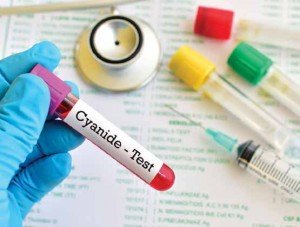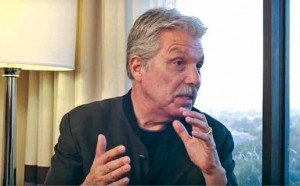The Incredible Story of Laetrile Part II: What Government Agencies and Big Pharma Don’t Want You to Know
Editor’s Note: This article is Part 2 of a 3-part series on an incredible cancer-fighting compound known as laetrile, and first appeared in the April 2017 edition of TTAC’s Heroes Against Cancer member newsletter.
In Part 1 we reviewed the historical theories about the causes of cancer, including a groundbreaking theory put forth in 1952 by Ernest Krebs, Jr., an American biochemist. Krebs proposed that cancer is caused by a deficiency of essential nutrients in our diet called nitrilosides, a compound found in over 1,200 edible plants including apricot, plum, and peach pits, apple seeds, bitter almonds, nuts, lima beans, and quince. Nitrilosides are also found in grasses, maize, sorghum, millet, cassava, linseed, and many other foods that are not consumed as part of the typical American diet.
The substance known as amygdalin or B-17 is a type of purified nitriloside that Krebs developed into a cancer treatment which he called Laetrile. In Part 2 we dive right into how Laetrile works to combat cancer, and some of the supporters and detractors of this controversial cancer therapy.
How Does Laetrile Fight Cancer?
Our blood contains millions of white blood cells known as natural killer (NK) cells, which are part of the immune system and whose job is to attack and destroy anything that is foreign and harmful to our bodies, including cancer cells.
However, cancer cells escape detection and killing by NK cells by presenting a “coat” of the patients’ own proteins on its cell surface. Such a coated cancer cell appears as “self” to the immune system and is not recognized as cancer. Enter Mother Nature’s solution…
As we saw in Part 1, nitrilosides are abundantly present in natural plant foods. Biochemist Ernst Krebs, Jr. purified a nitriloside known as amygdalin, a so-called “cyanogenic glucoside” – a compound that contains sugar and produces cyanide. In its concentrated and purified form that he developed especially for cancer therapy, it is known as Laetrile or laevo-mandelonitrile B-glucoside. Each molecule of amygdalin or Laetrile contains 2 units of sugar, one unit of benzaldehyde, and one of cyanide, all tightly bound together.
Incidentally, in the 1980s, Japanese scientists demonstrated that benzaldehyde is a non-toxic anti-cancer agent, along with being a powerful painkiller. Cyanide, on the other hand, can be highly toxic and even fatal if consumed in sufficient quantities. But here’s the interesting thing… when cyanide is locked chemically into a molecule of Laetrile, it is completely inactive and non-toxic and has no effect at all on living cells. Only one enzyme – known as beta-glucosidase – can unlock the Laetrile molecule, releasing one unit each of benzaldehyde and cyanide in the process.
Also of interest is that beta-glucosidase is only found to any significant extent in cancer cells, not in normal, non-cancerous cells. As a result, even if some Laetrile enters normal cells, nothing happens and the cells remain unharmed. However, when Laetrile enters cancer cells, it is enzymatically “unlocked” by beta-glucosidase and releases both poisonous cyanide and benzaldehyde – killing them.

While cyanide alone can be fatal, when cyanide is locked chemically into a molecule of Laetrile, it is completely inactive and non-toxic
The human body has an additional backup system to ensure our safety when we consume Laetrile or any other nitrilosides. Another enzyme known as rhodanase detoxifies any cyanide that is released within normal cells by converting it into byproducts, such as thiocyanates, that are harmless. Importantly, rhodanase is found in significant quantities in normal cells but not in cancer cells, which means any small quantities of released cyanide is non-toxic for normal cells.
In other words, cancer cells are much more susceptible to Laetrile and much less protected by rhodanese relative to non-cancerous cells. This intricate but powerful double-whammy mechanism seems to have been designed by nature to kill cancer cells while keeping us safe, naturally.
Proponents of Laetrile Therapy: Quacks or Distinguished Scientists?
The claims for the anti-cancer properties of Laetrile – despite being strongly disputed by the American Medical Association (AMA), the American Cancer Society, the National Cancer Institute (NCI), and the U.S. Food and Drug Administration (FDA) as a fraud – have plenty of high-profile, scientifically and medically credible supporters.
One of them is Dr. Hans Nieper, Director of the Department of Medicine at the Silversea Hospital in Hannover, Germany, and a world-renowned cancer specialist who served as the President of the German Society for Clinical Oncology. Dr. Nieper spent his entire career at the cutting edge of innovative, life-saving medicine and clinical research. He developed metabolic medicine as a successful non-toxic alternative to chemotherapy for treating cancer and other life-threatening chronic diseases. Dr. Nieper is a pioneer in the medical use of cobalt and is also credited with developing the anti-cancer drug cyclophosphamide.
Dr. Nieper’s book, The Curious Man, documents his successful treatment of over 3,000 American patients with multiple sclerosis (MS), as well as his remarkable success in achieving cancer remissions in many cancer patients, including Alicia Buttons, wife of the comedian Red Buttons.
It is a little-known fact that Dr. Nieper was employed at the Memorial Sloan-Kettering Cancer Center and worked closely with Robert A. Good, MD, President of Sloan-Kettering Institute; Lloyd J. Old, MD, Vice-President; Dr. Chester Stock, another Vice-President; and the President of the overall corporation, Lewis Thomas, MD.
The biochemist and cancer researcher Dr. Dean Burk was another outspoken proponent of Laetrile. Dr. Burk was chief of cytochemistry at the National Cancer Institute’s (NCI) laboratory and published more than 250 scientific articles during his long and distinguished scientific career. These are just a few of Dr. Burk’s accomplishments:
- He received the Hildebrand Prize in 1952 for his work on photosynthesis, the process by which plants make starch and sugar from air and water with the aid of sunlight.
- He won the Gerhard Domagk Prize in 1965 for his development of procedures to distinguish between a normal and cancerous cell.
- He co-developed the prototype of the nuclear magnetic resonance (NMR) scanner, an imaging device frequently used in medicine instead of X-rays.
- He was also a co-discoverer of biotin, one of the B-complex vitamins.
Based on his own research findings, Dr. Burk reported that Laetrile had no effect on normal cells, but released so much cyanide and benzaldehyde when it came into contact with cancer cells that none of them survived. He stated: “When we add Laetrile to a cancer culture under a microscope, we can see the cancer cells dying off like flies.”
Next on this list of laetrile supporters is Dr. Kanematsu Sugiura, a distinguished research scientist who spent most of his career as a committed research scientist at Memorial Sloan-Kettering Cancer Center. Dr. Sugiura wrote more than 250 scientific papers and received numerous awards, including the Leonard Prize of the Roentgen Society for his work on radiation biology. In 1965, the Japan Medical Association presented him with their highest award for his outstanding contributions to cancer research. In 1966, the New York city mayor and the New York County Medical Society recognized him for his cultural services and his contributions to the field of medicine.
Dr. Sugiura worked directly on Laetrile at Sloan-Kettering. As reported by Dr. Ralph W. Moss in his seminal book, “Doctored Results: The Suppression of Laetrile at Sloan-Kettering Institute for Cancer Research,” Dr. Sugiura’s meticulous research on mice clearly showed that cancer cells in their bodies stopped growing for many weeks when exposed to Laetrile. Mice that only received saline (salt) solution went on to develop metastatic cancer in their lungs 80-90% of the time, as opposed to Laetrile-treated animals which showed metastases 10-20% of the time.
Other well-known supporters of Laetrile include:
- Dr. N.R. Bouziane, MD, Director of the Research Laboratories at Hôpital Ste Jeanne d’Arc in Montreal and member of the Hospital’s Tumor Board in charge of chemotherapy.
- Dr. Manuel Navarro, MD, Professor of Medicine and Surgery at the University of Santo Tomas Hospital in Manila, the Philippines, and an internationally renowned cancer researcher.
- Dr. Ernesto Contreras, MD, Director of the Oasis of Hope Cancer Clinic in Tijuana, Mexico. He received his postgraduate training at Harvard’s Children’s Hospital in Boston and served as Professor of Histology and Pathology at the Mexican Army Medical School and as the Chief Pathologist at the Army Hospital in Mexico City.

Dr. Francisco Contreras shared how his father Ernesto learned of Laetrile and how the Oasis of Hope clinic started offering Laetrile therapy in Episode 8 of TTAC’s “The Quest For The Cures Continues” docu-series
The unwavering support of these esteemed scientists and clinicians lends considerable credibility to the trophoblastic thesis of cancer – which states that deficiency of nitrilosides in our modern diet is the underlying cause of the modern cancer epidemic – and to Laetrile’s critical role in its treatment and cure.
In fact, medical and research professionals from more than 20 countries including the U.S., vouch for Laetrile. They have all reported that the majority of their patients experienced an immediate lowering of blood pressure, improved appetite, increased hemoglobin and red blood cell counts, and above all, a release from pain without narcotics. If Laetrile treatment was started early enough, their cancer disappeared and they recovered. Even if a patient did begin Laetrile therapy when it was too late to be saved, the relief from pain they experienced was a merciful blessing to them and their families as they passed.
If Laetrile Is So Effective, Why Aren’t Doctors Using It Today?
If indeed Laetrile is so spectacularly effective and safe, why don’t we hear more about it in the news? Why aren’t people given the option of being treated with Laetrile when they are diagnosed with cancer?
The short answer is… because Laetrile does NOT have the approval and support of the U.S. Food and Drug Administration (FDA), the American Cancer Society (ACC), and the American Medical Association (AMA), who have all publicly labeled it as fraud and its proponents as “quacks.”
In fact, the FDA, and other agencies have used every means at their disposal to prevent this story from being told. They’ve arrested citizens for holding public meetings to tell others of their convictions on this matter. They’ve confiscated films and books. Doctors using Laetrile were arrested, their medical licenses revoked, and their patient records and medical supplies confiscated – even though they had achieved remarkable success. Even U.S. citizens who purchased Laetrile in Mexico and brought it back home for their own treatment were arrested for bringing an “illegal drug” across the border.
The evidence is conclusive. Laetrile can prevent the growth and even invasion of many different types of cancer cells in culture. But what about in actual patients? Next week we’ll look at five actual human case studies demonstrating the effectiveness of Laetrile and delve into the cover-up of this therapy by the American medical establishment. Stay tuned for the exciting conclusion!
Would you like to know ALL the ways to prevent, treat, and beat cancer? If so, you’ll love what you discover here.
Tags:
Replies to This Discussion
"Destroying the New World Order"
THANK YOU FOR SUPPORTING THE SITE!
Latest Activity
- Top News
- ·
- Everything
All In The Family | Mike Meets Archie For The First Time | The Norman Lear Effect
In the Political Realm They've Gone One Step Too Far!
All In The Family | Mike Meets Archie For The First Time | The Norman Lear Effect
America Copied Germany’s Jerry Can — But Missed The One Genius Detail that Made All the Difference
© 2026 Created by truth.
Powered by
![]()